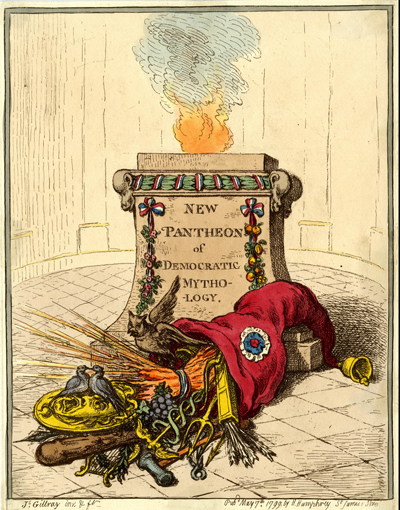New Pantheon of Democratic Mythology
This is the frontispiece to a series of prints portraying major Whig politicians as well-known figures from classical mythology. The series includes:
- Charles James Fox - Hercules
- George Walpole - Mars
- George Tierney, George Shuckburgh-Evelyn, and Joseph Jekyll - Harpies
- John Nicholls - Cupid
- Charles Sturt and George Barclay - Castor and Pollux
- Duke of Bedford - a Centaur

© Trustees of the British Museum
Like the title page for Egyptian Sketches, the frontispiece for a New Pantheon of Democratic Mythology suggests that French revolutionaries are once again attempting to co-opt a culture for their own purposes. In the Egyptian Sketches a sans-culotte monkey was climbing the symbol of Egypt, a pyramid, to place a bonnet rouge upon its apex. Here we see a classical-looking sacrificial altar which is already adorned with revolutionary tri-color ribbons. Contained within the over-sized bonnet rouge in front of it, we see traditional symbols of classical mythology: the thunderbolts of Zeus, the caduceus of Mercury, the club of Hercules, the trident of Nepture, the arrows of Cupid, the grapes of Bacchus, the lyre of Apollo, the owl of Minerva, the shield of Mars, and the love birds of Venus.
But again like the Egyptian Sketches, the frontispiece of New Pantheon of Democratic Mythology is deeply ironic. The symbols of classical culture are not truly "contained" by the revolutionary bonnet rouge, but spill out beyond it. And in fact the bonnet rouge is a fool's cap (with bell).The rams, that typically appear at the four corners of the altar, have been replaced by monkeys' heads. And it may not be out of place to remember that Londoners of 1799 would have associated a "Pantheon" not only with a list of notables but also with the failing building on Oxford Street that had already burned down once and was in financial trouble again.
The prints that follow fall into the general category of portrait caricature—mostly full-length single figures portrayed against a minimal background. And of course one aspect of the satire is the parody of full length portraits which seek to elevate their subjects by portraying them as classical figures or in classical poses. But in this case the comparison works to denigrate the subjects. Fox, as we have seen earlier in The Republican-Hercules Defending his Country is emphatically NOT Hercules. John Nicholls is positively laughable as "blind Cupid." And the diminutive George Walpole as Mars could not be less like the fearsome god of war.
Between 1775 and 1795, Gillray produced only one series, if indeed it can be called that—the set of thirteen ethnographic plates devoted to the dress and appearance of a range of Turkish figures. In the next five years alone, however, he published seven series of prints, beginning with the Eloquence series and including Hollandia Regenerata, the Consequences of a Successful French Invasion, French Habits, the Egyptian Sketches, and this one, the New Pantheon of Democratic Mythology.
Some of these series can be explained as extended arguments against French revolutionary actions and principles that could not be compassed in a single print. But especially the last three would seem to have had (at least for Gillray) a more obvious profit motive. As the sophistication and quality of caricature in general grew, prints, especially those produced by Gillray and Rowlandson, began to be seen as collectibles. But if prints were part of a series, there was a clear incentive for buying not just one isolated print, but a number of prints to complete the set.
For Gillray, series like Eloquence, French Habits, and the New Pantheon of Democratic Mythology also had the advantage of less time sensitivity. Because the satire was more general—tied to a person rather than a specific event— he was not racing against a competitor to publish an immediate response He could take more time and spend more effort to make the print aesthetically satisfying. The result is that these prints are some of Gillray's most polished and memorable images, but lacking in the subtlety and ambivalence of his responses to immediate and still unfolding events.
Sources and Reading
- Commentary from the British Museum on New Pantheon of Democratic Mythology.
- Draper Hill, Mr. Gillray The Caricaturist, 1965 p. 81n.
- "Pantheon, Rome," Wikipedia
- "The Pantheon," British History Online
- Thomas Wright and R.H. Evans, Historical and Descriptive Account of the Caricatures of James Gillray #230.
- Thomas Wright and Joseph Grego, The Works of James Gillray, the Caricaturist; With the History of His Life and Times, p. 258.
Comments & Corrections
NOTE: Comments and/or corrections are always appreciated. To make that easier, I have included a form below that you can use. I promise never to share any of the info provided without your express permission.